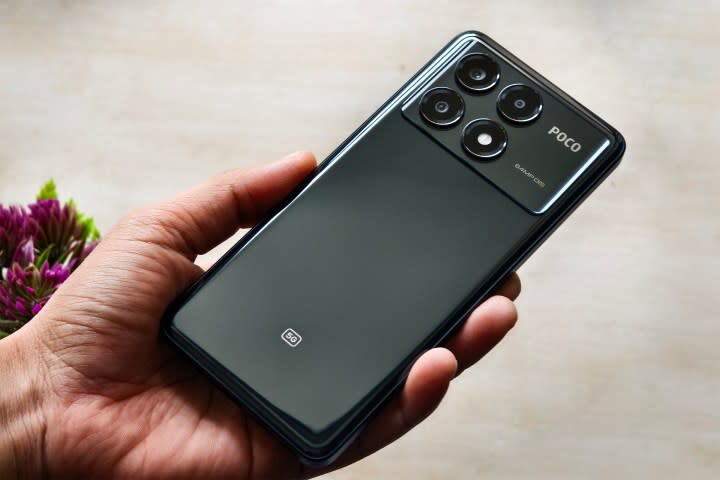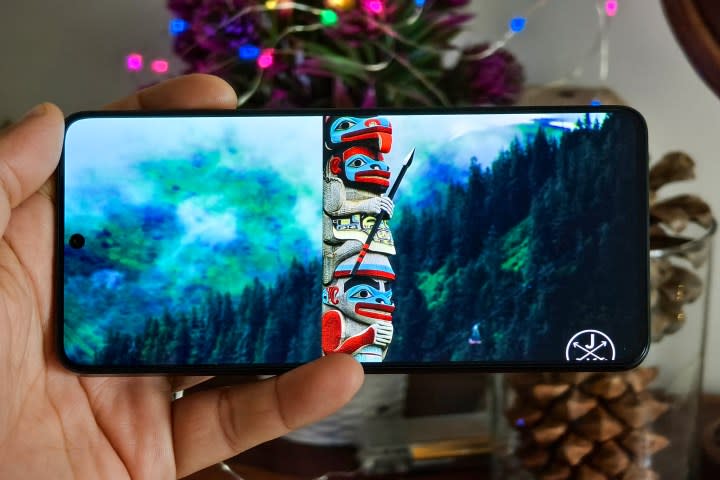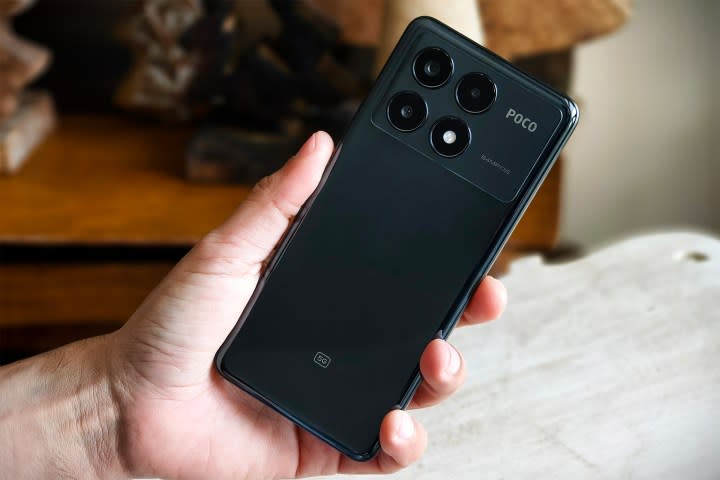This $375 Android phone surprised the heck out of me

“There’s plenty of fish in the sea.” Besides its usual romantic denotation, the idiom fits the segment of Android phones very well. Android phones come with countess variations that go unseen or underappreciated in the shadow of the iPhone and Samsung Galaxy phones. There will be an Android device for every (reasonable) permutation of specifications you can conceive.
But, the Poco X6 Pro is unlike other fish in the sea. For its launch price of 350 euros (around $375 USD), the mid-ranger from Xiaomi’s spin-off brand (and successor to the Poco X5 Pro we reviewed last year) is packed with many features that feel unusual at this price. Besides being classified as a mid-range Android phone, the Poco X6 Pro aspires to compete with flagships — or flagship killers.
Here’s why the Poco X6 Pro feels unlike any other phone in its segment.
A display that stuns

AMOLED displays on mid-range phones aren’t uncommon these days. So, Poco goes a step further and takes it up a notch by increasing the sharpness of the X6 Pro’s display. Instead of the regular Full HD resolution, the Poco X6 Pro’s display sports a 1.5K (1220 x 2712 pixels) — which appears to be a middle ground that proactive brands now choose to increase the display’s sharpness slightly without a full-blown upgrade to a Quad HD resolution. The same can be seen on the spectacular OnePlus 12R.
This choice of a slightly bumped-up resolution allows for crisp visuals and better readability, even with smaller font sizes. The display measures 6.67 inches and has a 120Hz refresh rate. To save battery, the display’s refresh rate automatically lowers to 60Hz based on the usage — or 30Hz on the always-on display.
Besides being crisp and agile, the display also gets plenty bright. Poco officially claims a brightness of 1,200 nits in the High Brightness Mode (when adjusted manually) and 1,800 nits of peak brightness. The latter enables a rich contrast while watching HDR content.

Besides standard HDR codes such as HDR10, the display is also certified for proprietary codecs such as Dolby Vision and HDR10+, enabling a more engrossing visual experience on apps such as Netflix, Amazon Prime Video, Apple TV Plus, etc. If you’re playing YouTube, HDR videos play with richer colors and
Lastly, what makes the display experience even more satisfying for me is the presence of an in-display fingerprint scanner — a feature largely restricted to the categories of flagship and sub-flagship phones.
Unmatched performance for this price

The next major highlight that makes the Poco X6 Pro an unequaled offering at this price is the processor inside it. It runs on the MediaTek Dimensity 8300, which Poco claims can overpower flagship chipsets such as the Qualcomm Snapdragon 8+ Gen 1 and the MediaTek Dimensity 9000. Although these claims speak a lot about the chipset’s performance, they are not surprising.
Both of the processors that Poco compares the Dimensity 8300 to are two generations older (and initially announced in late 2021) and MediaTek has achieved better performance by applying economies of scale. Interestingly, the Dimensity 8300 even uses a core structure comparable to the following generations, i.e., Snapdargon 8 Gen 2 and Dimensity 9100, but without the Cortex-X cores deployed for peak performance on flagship devices.
As a result, the Dimensity 8300’s actual performance lies between the two-generation old and one-generation old flagship chips. We can verify this by running a couple of synthetic benchmarks. The first one, Geekbench 6, clearly shows where the Dimensity 8300’s CPU performance lies between the Snapdragon 8+ Gen 1 (from the OnePlus 10T) and the Snapdragon 8 Gen 2 (from the OnePlus 11/12R).

A surprising trend is seen while running another synthetic benchmark, Burnout Benchmark, which determines the effect of continuous and sustained loads on a phone’s performance. Despite early peaking on both the actual flagship chips, the Dimensity 8300 on the Poco X6 Pro delivers better sustained performance than the others.

The Dimensity 8300’s CPU performs splendidly well, giving us a vibrant picture of how well it will handle most tasks you expect of a smartphone. But what about graphics-intensive tasks, especially gaming? Our testing with the Burnout Benchmark suggests that, unlike the CPU, the GPU may lag behind the other two in our test batch by a long margin.

While this set my expectations low, I was absolutely surprised by the actual gaming performance of the Poco X6 Pro. During my testing, I played several rigorous and demanding games such as Call of Duty: Mobile, Diablo Immortal, and Genshin Impact — and tested the phone’s performance with Gamebench.
First, the Poco X6 Pro runs at the highest supported settings on all games. While each game warned me of the hardware insufficiencies, I never experienced any issues while actually gaming on the phone. During one of my sessions of Genshin Impact, I played continuously for an hour. I set the graphics quality to the “highest” setting and the frame rate to 60fps. I constantly monitored the performance with Gamebench since the tool can capture nuances that the eyes may miss.

I was astonished to see that even after an hour of gameplay, the phone was effortlessly churning out frames at 60fps without any stuttering or lag. While the internal temperature rose from 20 degrees to 40 degrees Celsius (68 to 104 degrees Fahrenheit), I could barely feel the warming up on the outside. My eyes — and willpower — gave up before the phone; otherwise, it could easily carry on for another hour.
Besides the functional hardware, subtleties about the Poco X6 Pro that cannot be overlooked are the technologies the company uses for RAM and storage. The X6 Pro gets up to 12GB of LPDDR5X RAM and 512GB of UFS 4.0 storage — both of which are the fastest pieces of technology for mobile phones so far.
And this is what brings me back to the surprising part. As I said above, the X6 Pro’s chipset replicating a two-year-old flagship chip is not what excites me; it’s the fact that you get this performance for a devilishly good price.
Fast charging fuels the action

While the Poco X6 Pro’s vibrant display and powerful processor demand a lot from the 5,000mAh battery, it churns out enough power through a day’s labor. Although large batteries such as this one are useful for a longer-lasting backup, charging them also takes longer and can feel like a hassle.
To remedy this, the Poco X6 Pro has 67W fast charging, and the wall adapter is included in the box. A full charge takes about 45 minutes to complete, with 80% completing within half an hour. Fast charging doesn’t slow down significantly, even when the phone is being used — or gamed on.
For this, Poco uses Xiaomi’s proprietary fast-charging technology. Using a standard USB-C charger, you will be stuck at slower speeds. But for most other times, the fast charging is a bonus.
Deleting bloatware is easier than ever
Admittedly, one of the factors helping Poco keep the phone’s price lower than the competition is pre-installing certain apps on your phone. There are broadly two ways in which brands leverage apps to earn commission from the apps’ publishers — and, therefore, earn back some of the profits they relinquish while pricing the phone aggressively. The first is by pre-installing a boatload of apps on your phone, and the second is by installing their own app stores, which are usually less moderated than the Google Play Store and may allow shady or rogue apps to be published.
Most phone brands, including stalwarts like Samsung, engage in these practices, but only Chinese brands are largely criticized for them. Poco isn’t alien to this practice, and you will find countless unwanted apps pre-installed on the X6 Pro.
But if you’re proactive about getting rid of these apps, uninstalling them is a tad easier. This is because Poco X6 Pro runs Xiaomi’s new HyperOS interface instead of the previously popular MIUI. The new OS is designed to be interoperable on different platforms other than phones — such as smartwatches, TVs, and even Xiaomi’s new autonomous electric car — with minimum modifications to the code.
On phones specifically, HyperOS makes it easier to uninstall apps you don’t want, including system apps such as the stock music and video player apps. With some diligence, any unwanted app can be scrubbed off. HyperOS also allows you to select multiple apps from the home screen and initiate a mass delete at once; however, you will still need to agree to individual prompts for deleting each app.
If you want a deeper cleanse, you can use the Universal Android Debloater tool to uninstall apps, including Xiaomi’s own app store, Gallery, or Messages apps.
An incredible deal … if you can buy it

Since its inception in 2018, Poco has defied trends and launched phones at unbelievably low prices. Since then, the brand has branched into different segments and adjusted its strategies according to each. Yet a common tendency to disrupt remains — and this can be felt coming off very aggressively from the Poco X6 Pro.
The phone challenges the norms of the sub-$400 segment, which is otherwise dedicated to just-alright but unimpressive Android phones. The X6 Pro exceeds the competition, especially with its performance and display, making it one of the most appealing budget phones for entertainment and gaming. There are some obvious drawbacks, especially with the software or the lack of fast charging support for open standards, but it’s mostly tamable.
Despite these, it’s vital to note that folks in the U.S. cannot buy this phone, even though the brand enjoys much loyalty in Europe. You can probably get it on Amazon, beware these units are imported from Europe and do not come with any warranty. Even if you have the phone, it will not work with most carriers in the U.S., making it a bad deal. But for those in the U.K. or Europe, the Poco X6 Pro is a sweet deal — especially if you otherwise feel cramped by offerings from the likes of Samsung and Google, which charge hefty premiums for their brand names.



